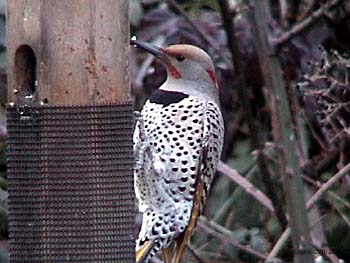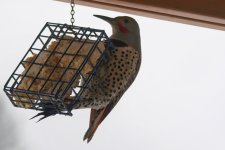-
Welcome to BirdForum, the internet's largest birding community with thousands of members from all over the world. The forums are dedicated to wild birds, birding, binoculars and equipment and all that goes with it.
Please register for an account to take part in the discussions in the forum, post your pictures in the gallery and more.
You are using an out of date browser. It may not display this or other websites correctly.
You should upgrade or use an alternative browser.
You should upgrade or use an alternative browser.
Northern Flicker? (Y/N) (1 Viewer)
- Thread starter TGNWest
- Start date
More options
Who Replied?Earnest lad
Well-known member
I think the red moustachial stripe indicates a red-shafted one.

That is what I was thinking as well 👍I think the red moustachial stripe indicates a red-shafted one.
lockbreeze926
Well-known member

This is quite right.I think the red moustachial stripe indicates a red-shafted one.
Also, the red-shafted sub-species is what you'd expect in N ID.
buckofdurham
Well-known member

The mustache indicates that it's a male N Flicker. It's also called a Yellow Hammer. It's a beautiful bird. Nice pic, they don't stand still long.
I took this pic last month in Indiana.

I took this pic last month in Indiana.
Last edited:
buckofdurham
Well-known member

I hope not. If you look close in the pic I took. It looks like their is moisture perhaps even ice in her cheek feathers. I hope she's alright.The snow doesn't seem to bother them.
buckofdurham
Well-known member

The pic I took is a female. I am pretty sure if it were a male it would have the black mustache.
Regarding the initial post, it is just as you think, a Northern Flicker, and everything we can see suggests it is the red-shafted form: salmon-red in the wings and tail (rather than yellow), a gray face (rather than brown), a plain brown nape (rather than with a red band), and a red moustachial stripe (rather than black). The moustachial stripe indicates it is a male. Intergrades between the red- and yellow-shafted are common and widespread, and can seemingly combine any combination of features. Check the flickers you see carefully and you may well see one with some of the features of the yellow-shafted form.
Last edited:
Earnest lad
Well-known member
Are intergrades common in all areas, or is there an "intermediate" zone between the respective ranges in which one commonly finds intergrades but not elsewhere?Regarding the initial post, it is just as you think, a Northern Flicker, and everything we can see suggests it is the red-shafted form: salmon-red in the wings and tail (rather than yellow), a gray face (rather than brown), a plain brown nape (rather than with a red band), and a red moustachial stripe (rather than black). The moustachial stripe indicates it is a male. Intergrades between the red- and yellow-shafted are common and widespread, and can seemingly combine any combination of features. Check the flickers you see carefully and you may well see one with some of the features of the yellow-shafted form.
Earnest lad
Well-known member
Thank you so much.I do not know the exact distribution of intergrades, but I see some in California most winters. If they are here, they must be fairly widespread.
buckofdurham
Well-known member

I borrowed this pic of a integrated from Birds Amore in Oregon


Users who are viewing this thread
Total: 2 (members: 0, guests: 2)




